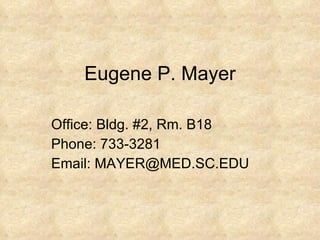
Innate Immunity06
- 1. Eugene P. Mayer Office: Bldg. #2, Rm. B18 Phone: 733-3281 Email: MAYER@MED.SC.EDU
- 3. Overview of the Immune System Interactions between the two systems Immune System Innate (Nonspecific) 1 o line of defense Adaptive (Specific) 2 o line of defense Protects/re-exposure Cellular Components Humoral Components Cellular Components Humoral Components
- 5. Cells of the Immune System Immune System Myeloid Cells Lymphoid Cells Granulocytic Monocytic T cells B cells Neutrophils Basophils Eosinophils Macrophages Kupffer cells Dendritic cells Helper cells Suppressor cells Cytotoxic cells Plasma cells NK cells
- 6. Development of the Immune System ery pl mye neu m φ lym nk thy CD8 + CD4 + CTL TH2 TH1
- 8. Infection and Immunity Balance infection immunity Bolus of infection x virulence immunity Disease =
- 10. Overview of the Immune System Immune System Innate (Nonspecific) Adaptive (Specific) Cellular Components Humoral Components Cellular Components Humoral Components
- 12. Anatomical Barriers - Mechanical Factors Flushing action of tears, saliva, mucus, urine Epithelium ( e.g. nasopharynx) Mucociliary elevator Ciliated epithelium ( e.g. respiratory tract) Peristalsis Non-ciliated epithelium ( e.g. GI tract) Mucous Membranes Physical barrier Desquamation Squamous epithelium Skin Mechanism Cell type System or Organ
- 13. Anatomical Barriers - Chemical Factors Opsonin Sufactants (lung) Antimicrobial Defensins (respiratory & GI tract) Low pH Lysozyme and phospholipase A HCl (parietal cells) Tears and saliva Mucous Membranes Anti-microbial fatty acids Sweat Skin Mechanism Component System or Organ
- 14. Anatomical Barriers - Biological Factors Antimicrobial substances Competition for nutrients and colonization Normal flora Skin and mucous membranes Mechanism Component System or Organ
- 15. Humoral Components Compete with bacteria for iron Lactoferrin and transferrin Increase vascular permeability Recruitment of phagocytic cells Β -lysin from platelets – a cationic detergent Coagulation system Lysis of bacteria and some viruses Opsonin Increase in vascular permeability Recruitment and activation of phagocytic cells Complement Various effects Cytokines Breaks down bacterial cell walls Lysozyme Mechanism Component
- 16. Cellular Components Killing of virus-infected and altered self targets NK and LAK cells Killing of certain parasites Eosinophils Phagocytosis and intracellular killing Extracellular killing of infected or altered self targets Tissue repair Antigen presentation for specific immune response Macrophages Phagocytosis and intracellular killing Inflammation and tissue damage Neutrophils Functions Cell
- 17. Phagocytosis and Intracellular Killing
- 19. Characteristics of Neutrophil Granules primary granules contain cationic proteins, lysozyme, defensins, elastase and myeloperoxidase secondary granules contain lysozyme, NADPH oxidase components, lactoferrin and B12-binding protein azurophilic; characteristic of young neutrophils; specific for mature neutrophils
- 22. Attachment via Receptors: IgG FcR ScavengerR Complement R Toll-like R Initiation of Phagocytosis
- 24. Respiratory Burst Oxygen-Dependent Myeloperoxidase-Independent Reactions Toxic compounds – Superoxide anion (O 2 - ), Hydrogen peroxide (H 2 O 2 ), Singlet oxygen ( 1 O 2 ) and Hydroxyl radical (OH*) Pentose-P + NADPH G-6-P-dehydrogenase Glucose +NADP + NADPH oxidase Cytochrome b558 NADP + + O 2 - NADPH + O 2 Superoxide dismutase H 2 O 2 + 1 O 2 2O 2 - + 2H + 2O 2 - + H 2 O 2 OH* + OH - + 1 O 2
- 25. Respiratory Burst Oxygen-Dependent Myeloperoxidase-Dependent Reactions myeloperoxidase OCl - + H 2 O H 2 O 2 + Cl - 2OCl - + H 2 O 1 O 2 + Cl - + H 2 O Toxic compounds – Hypochlorous acid (OCl - ), and Singlet oxygen ( 1 O 2 )
- 26. Respiratory Burst Detoxification Reactions H 2 O 2 + O 2 Superoxide dismutase H 2 O + O 2 Catalase 2O 2 - + 2H + 2 H 2 O 2
- 27. Oxygen-Independent Killing in the Phagolysosome Effector Molecule Function Cationic proteins (cathepsin) Damage to microbial membranes Lysozyme Hydrolyses mucopeptides in the cell wall Lactoferrin Deprives pathogens of iron Hydrolytic enzymes (proteases) Digests killed organisms
- 28. Summary of Intracellular Killing Pathways Intracellular Killing Oxygen Dependent Oxygen Independent Myleoperoxidase Dependent Myleoperoxidase Independent
- 29. Nitric Oxide Dependent Killing IFN γ TNF TNF Nitric Oxide Nitric Oxide
- 32. Lymphokine Activated Killer (LAK) cell IL2 IFN IFN IL2 kills malignant cells kills transformed and malignant cells